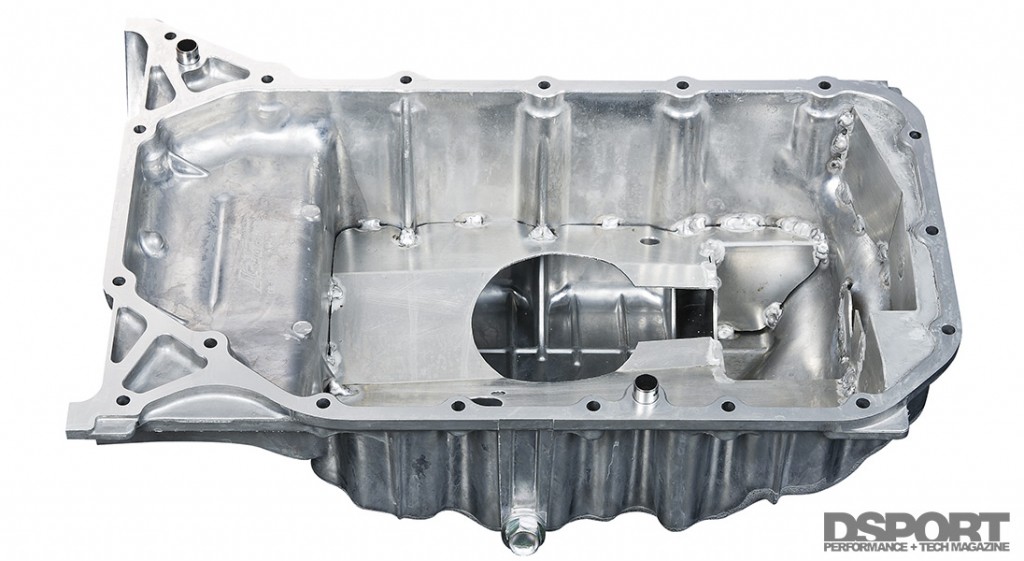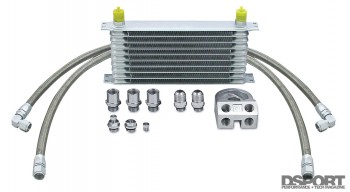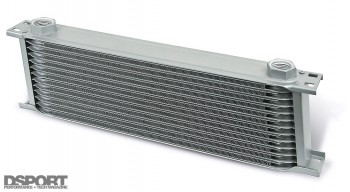 Trap doors and baffle plates help to keep oil from sloshing away from the oil pickup
Trap doors and baffle plates help to keep oil from sloshing away from the oil pickup
Battle Ready
A high-performance dry-sump system is the ultimate oiling system for any engine, however there are opportunities to improve a wet-sump system. By upgrading to an aftermarket oil pan that uses trap doors and baffles, oil starvation becomes less likely. The trap doors and baffles prevent oil from sloshing away from the pickup during hard cornering. Most aftermarket oil pans also feature a larger sump for extra oil capacity, again reducing the chances of oil starvation. Some aftermarket pans also feature a built-in windage tray to help increase power by preventing the oil in the pan from sloshing up into the rotating assembly. To free up some additional power, aftermarket crank scrapers can be installed to remove excess oil from the counterweights of the spinning crankshaft.
 Some aftermarket oil pans increase the oil capacity to prevent oil starvation
Some aftermarket oil pans increase the oil capacity to prevent oil starvation
Hot, Hot, Hot
For the internal components of the engine, heat is the enemy. The more horsepower an engine makes, the more heat it creates. Thermal breakdown causes oil to lose its viscosity over time. As an oil loses its viscosity and shear strength, the chances of damaging metal-to-metal contact increase. Aftermarket oil coolers reduce oil temperatures allowing the engine oil to maintain its viscocity for optimum protection and longevity.
Oil cooler kits sometimes include an oil filter sandwich plate and lines to ease the installation. Oil cooler cores come in various sizes for various applications.
Scraping By The Crank Scraper
A great deal of oil is thrown around inside an engine during normal operation. While conventional wisdom may dictate that having oil everywhere is beneficial, the truth of the matter is that it is actually detrimental to engine performance and longevity. As RPMs rise, the oil forms a cloud. When this aerated oil cloud is sucked into the oil pump it can cause random oil pressure drops inside the galleys of the engine. These pressure drops represent times when the engine is not being lubricated adequately and are an indication that permanent engine damage is just around the corner.
A crank scraper is a piece of metal that is positioned very near the path of a spinning crankshaft. While the scraper does not come into physical contact with the rotating assembly, it is positioned incredibly close. As the rotating assembly passes by the scraper, the excess oil (that fills the gap between the rotating assembly and the scraper) is removed. Once removed, the oil is directed down into the pan towards the oil pump sump. Since the crank scraper acts as a physical barrier between the oil in the pan and the rotating assembly, it prevents the oil from being atomized into a cloud and keeps any aerated oil away from the oil pickup.
The 4G63 crank scraper we tested from TOMEI POWERED gained 4-peak horsepower.
Coupled with a windage tray, the crank scraper can also cut down on the mass of oil on the rotating assembly. When oil is attached to the crank, the rotating assembly carries more mass. This translates into a loss of power.
Keeping excess oil off of the crankshaft and rotating parts reduces this power loss. In addition to lowering rotating assembly mass, the oil mass reduction lowers drag and reduces windage, both of which result in even further increases in power, especially at higher RPMs. Our own independent testing with an aftermarket crank scraper kit showed an increase of four horsepower at the top end of the engine’s powerband.
When available, a crank scraper is something every car owner should consider installing, especially in the middle of an engine build where access to the rotating assembly area is unhindered. Aside from simply picking up a little extra power, a crank scraper should also increase gas mileage. Free power, better fuel economy and increased reliability make for a winning combination.




